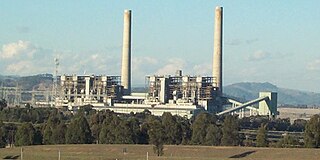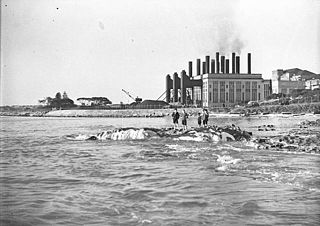
Longannet power station was a large coal-fired power station in Fife, and the last coal-fired power station in Scotland. It was capable of co-firing biomass, natural gas and sludge. The station stood on the north bank of the Firth of Forth, near Kincardine on Forth.

The Lakeview Generating Station was an Ontario Power Generation coal-burning power station located in Mississauga, Ontario, Canada, in the Lakeview neighbourhood on Lakeshore Road just east of Cawthra Road. The former station, constructed in 1958–1962, had four smokestacks known as the Four Sisters; the eight boilers of the generating plant all 'twinned' their emissions into common stacks. The station was a landmark for years and was shut down in April, 2005, after 43 years of service. The four stacks, which could be seen from as far away as Burlington to the west and downtown Toronto to the east, were demolished on June 12, 2006. The rest of the building was demolished on June 28, 2007.

Ballylumford power station "C" station is a natural-gas-fired power station in County Antrim, Northern Ireland, UK. With its main plant generating almost 700 megawatts of electricity, it is Northern Ireland's largest power station and provides half its power. Overall the station can produce 693 MW. The plant is located at the tip of the Islandmagee peninsula, which separates Larne Lough from the Irish Sea. The lough is a Site of Special Scientific Interest. The 3 chimneys of the now decommissioned "B" station are 126 metres tall. East of the station is the Ballycronan More converter station, the Northern Ireland end of the Moyle Interconnector, a subsea HVDC interconnector connecting the NI electricity system to Great Britain.

Eraring Power Station is a coal-fired power station consisting of four 720 MW Toshiba steam-driven turbo-alternators for a combined capacity of 2,880 MW. The station is located near the township of Dora Creek, on the western shore of Lake Macquarie, New South Wales, Australia and is owned and operated by Origin Energy. It is Australia's largest power station. The plant has two smokestacks rising 200 m (656 ft) in height. It is slated for closure by mid-2025, after a failed attempt to sell the loss making power station back to the state government.

Vales Point Power Station is one of two operating coal fired power stations on the shores of Lake Macquarie, New South Wales. Vales Point is located on the southern shore of the lake, near the township of Mannering Park. It has two steam turbines, with a total generating capacity of 1,320 MW (1,770,000 hp) of electricity.

Liddell Power Station is a decommissioned coal-fired thermal power station that had four 500 megawatts (670,000 hp) EE steam-driven turbine alternators, providing a combined electrical capacity of 2,000 megawatts (2,700,000 hp).

Wallerawang Power Station was a thermal coal power station, located near Wallerawang, in the Central Tablelands region of New South Wales, Australia. The power station was equipped with two turbo-alternators of 500 megawatts (670,000 hp) each, supplied by CA Parsons and Company of Newcastle-upon-Tyne, England. Production commenced in May 1957.

Aberthaw Power Station refers to two decommissioned coal-fired and co-fired biomass power stations on the coast of South Wales, near Barry in the Vale of Glamorgan. They were located at Limpert Bay, near the villages of Gileston and West Aberthaw. The most recent power station on the site, Aberthaw B Power Station, co-fired biomass and as of 2008 had a generating capacity of 1,560 megawatts (MW). The power station closed on 31 March 2020.

Wangi Power Station is a heritage-listed former coal-fired power station at Wangi Wangi, City of Lake Macquarie, New South Wales on Lake Macquarie. The power station operated between 1956 and 1986 and supplied electricity to New South Wales. It was once the largest in the state. The 12,000-square-metre (130,000 sq ft) building was listed on the New South Wales State Heritage Register on 2 April 1999.

Spencer Street Power Station was a Victorian era coal and (later) oil-fired power station which operated on Spencer Street in central Melbourne, Victoria, Australia. The station was opened in 1894 in order to power electric street lights, then supplied power to the city's residents, as well as being a wholesale supplier to other municipal distributors. It came under the management of the State Electricity Commission of Victoria in 1941. By the 1960s the capacity of the station reached 109 MW, but was used only for peak load. The station was closed in 1982 after becoming redundant. Eventually deemed an eyesore, demolition commenced in 2006 and was completed in 2008, and a large residential and retail development called Upper West Wide was completed by 2016.

The Newport Power Station was a complex of power stations located on the west bank of the Yarra River, approximately 6 km south-west of Melbourne, Victoria, Australia, in the suburb of Newport. Newport A, B, and C were coal-fired plants which operated at the site between 1919 and the 1980s, and were claimed to be the largest power station in the southern hemisphere in 1953 with 42 boilers and 14 turbo-alternators producing 327 megawatts (439,000 hp).

Bunnerong Power Station was a coal-fired power station in the south-eastern Sydney suburb of Matraville, New South Wales, Australia that was decommissioned by 1975 and subsequently demolished. When the last generating units were commissioned, it was the largest power station in the southern hemisphere, with a capacity of 375 megawatts (MW) from eleven turbo-alternators. It was able to supply up to one third of the state's electricity needs at the time. It remained the most powerful until the completion of Vales Point Power Station in 1966.

The Littlebrook Power Station were a series of four oil and coal-fired power stations situated on the south bank of the River Thames, next to the Queen Elizabeth 2 Bridge and the Dartford Tunnel in Dartford, Kent. The final power station, Littlebrook D, ceased operating in March 2015, and has now been demolished.

Great Yarmouth Power Station is combined cycle gas turbine power station on South Denes Road in Great Yarmouth in Norfolk, England, with a maximum output of 420 MW electricity, opened in 2001. It is built on the site of an oil-fired power station, built in 1958 and closed and demolished in the 1990s. A coal-fired power station was built in Great Yarmouth in 1894 and operated until 1961. The station is operated by RWE.

The Tilbury power stations were two thermal power stations on the north bank of the River Thames at Tilbury in Essex. The 360 MW dual coal- and oil-fired Tilbury A Power Station operated from 1956 until 1981 when it was mothballed, prior to demolition in 1999. The 1,428 MW Tilbury B Power Station operated between 1968 and 2013 and was fueled by coal, as well as co-firing with oil and, from 2011, biomass. Tilbury B was demolished in 2016–19. Since 2013 three other power stations have been proposed or constructed in Tilbury.

Chadderton Power Station refers to a series of two coal-fired power stations, which were situated at Chadderton, Greater Manchester in North West England.
Stuart Street Power Station was a coal-fired power station in Bradford, Manchester, England.
Meaford Power Station was a coal-fired power station situated on the River Trent at Meaford near Stone in Staffordshire.

Kirkstall Power Station was a coal-fired unit opened in 1930, serving the city of Leeds, West Yorkshire, England.
The Thornhill power station generated and supplied electricity to the town of Dewsbury and the wider regional area from 1902 to 1982, and again from 1998. The first generating station on the site was owned and operated by the Yorkshire Electric Power Company. Following nationalisation of the British electricity supply industry in 1948 Thornhill power station was operated by a succession of state owned bodies. The power station was redeveloped with new plant in 1915, 1925, 1932–37 and 1950–54. The coal-fired steam station was decommissioned in 1982, and was subsequently demolished. A gas turbine power station on the site was commissioned in 1998.


















